
- #JAVA BATCH SCRIPT EXAMPLE HOW TO#
- #JAVA BATCH SCRIPT EXAMPLE CODE#
- #JAVA BATCH SCRIPT EXAMPLE FREE#
Var fso = new ActiveXObject( "Scripting.FileSystemObject" )
#JAVA BATCH SCRIPT EXAMPLE CODE#
In addition, you cannot run the code on its own, it needs to be a part of a web page or a stand-alone HTML Application (HTA). Writing files via ActiveX is slightly more involved than using JavaScript Editor extensions: you create an instance of a FileSystemObject, create a file, write to it, and close it. View the page using Internal Viewer or Internet Explorerįso = new ActiveXObject( "Scripting.FileSystemObject" ) Įxample 5 (using ActiveX and a web page): Writing a file using JavaScript If(fh!= -1) // If the file has been successfully openedįwrite(fh, str) // Write the string to a fileĮxample 4 (using ActiveX and a web page): Listing available drivesĤ. Var fh = fopen( "c:\\MyFile.txt", 3) // Open the file for writing (Optional) Save the file as WriteFileExample.js, and Writing files using JavaScript and built-in extensions is straightforward: open the file for writing, write to a file and close a file.ģ. Write( "The contents of " + getCurrentFolder()) įileName = findFirstFile( "*.*" ) // Find the first file matching the filterįileName = findNextFile() // Find the next file matching the filterĮxample 3 (using extensions): Writing a file using JavaScript This example shows folder manipulation routines: it lists Note: if you do not save the file, getCurrentFolder() below will return an empty string. Str = fread(fh, length) // Read in the entire fileĮxample 2 (using extensions): Listing files in a folderģ. Length = flength(fh) // Get the length of the file

If (fh!=- 1 ) // If the file has been successfully opened Created with Antechinus® JavaScript Editorįh = fopen(getScriptPath(), 0 ) // Open the file for reading the contents of itself (the script file). This example shows file manipulation routines: it echoes Note: If you do not save the file, getScriptPath() below will return an empty string. Example 1 (using extensions): Reading a file When using extensions, all you need to do is select Build / Execute from the menu and let JavaScript Editor do the job. You need a web page to run your JavaScript, andĪctiveX objects only work with the Internet Explorer browser. Using ActiveX objects gives you many possibilities, but there are two distinct disadvantages: Using a web page and ActiveX objects (Internet Explorer only)

Using JavaScript extensions (runs from JavaScript Editor), orĢ.

How can you use JavaScript to access your local files and folders? Currently there are two ways to do it:ġ. Well, you can! Not through the Internet of course, but internally on your computer, or on your intranet if you have one. Why not use your knowledge of JavaScript for batch processing of local files and other common tasks? JavaScript is a simple yet very powerful scripting language.
#JAVA BATCH SCRIPT EXAMPLE HOW TO#
How to read and write files in JavaScriptĪre you looking for the ways to access the file system using JavaScript? If your JavaScript code could access local files of the visitor to your site, it would be a huge security problem. The libraries are compiled, rated and maintained by JavaScriptDeveloper. For creating advanced web applications, get the JavaScript framework from JavaScript and AJAX Libraries.
#JAVA BATCH SCRIPT EXAMPLE FREE#
Get ready-to-use solutions at our free JavaScripts and HTML code section.Ĥ. Become JavaScript expert in 10 hours or less, with JavaScript Editor's step-by-step hands-on tutorials.įree online hands-on JavaScript tutorial and AJAX tutorial are also available.ģ. It can handle everything from designing tools like the pregnancy calculator.Ģ. Get the best JavaScript and AJAX editor.ĭesigning stunning web applications and pages is quick and effortless with JavaScript Editor. JavaScript is fun - and creating great websites without it is next to impossible.ġ.


 0 kommentar(er)
0 kommentar(er)
